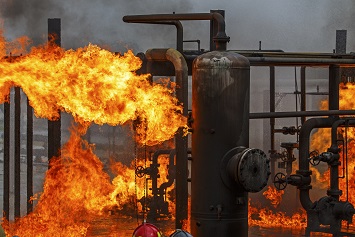Explosions and fires at oil refineries and chemical facilities are far more likely to occur during equipment start-ups and shutdowns, notes the U.S. Chemical Safety and Hazard Investigation Board (CSB) in a recent Safety Digest. Workers are typically the first line of victims when such incidents occur. In the Digest, the CSB describes three start-up/shutdown incidents it investigated in which collectively 5 workers were killed and 11 injured.
“To prevent these types of incidents from occurring, facilities should employ effective communication, provide workers with appropriate training, and have in place strong and up-to-date policies and procedures for hazardous operations such as startups and shutdowns,” says the CSB.
The Safety Digest lists 11 lessons learned from its investigations. Below we note those that relate specifically to worker safety.
Hazardous Activity
A start-up is a planned series of steps to take a process from an idle, at-rest state to normal operation. A shutdown is the reverse sequence.
According to the Center for Chemical Process Safety (CCPS), an industry-sponsored membership organization that identifies and addresses process safety needs within the chemical, pharmaceutical, and petroleum industries, the majority of process safety incidents occur during start-up even though these actions represent only a small portion of the operating life of a plant. The CCPS states that process safety incidents occur five times more often during start-up than during normal operations. Also, a 2010 study of incidents in the refining industry found that 50 percent of process safety incidents occur during start-ups, shutdowns, and other events that infrequently occur.
“This is because the startup and shutdown periods involve many non-routine procedures, and these periods can result in unexpected and unusual situations,” says the CSB.
Recommendations
“Key principles” employers could have followed, which the CSB believes may have prevented the three accidents, and which relate specifically to employees, include the following:
- Communicate the essential elements of new operating procedures in writing.
- Communicate potential hazards and safe operating limits in writing.
- Provide training in new procedures commensurate with their complexity.
- Ensure the facility’s lockout/tagout program requires that equipment is rendered safe before opening for inspection or maintenance. Equipment opening procedures should contain a stop work provision that requires higher levels of management’s review and approval when safe opening conditions, such as equipment depressurization, cannot be verified.
- In complex and critical process systems, multichannel communication with feedback provides the best opportunity for operators to establish and maintain a mutual understanding of the process unit and its expected future state. During times of abnormal operating conditions, such as unit start-up, the risk of operators having dissimilar or incompatible understandings of the state of the process unit is even greater, making effective communication vital and feedback essential.
- Ensure that operators are supervised and supported by experienced, technically trained personnel during unit start-ups and shutdowns and that they are sufficiently trained on the control systems that they will be operating. Consideration should be given to the use of simulators for training operators in abnormal situations during start-ups and shutdowns.
- For high-hazard processes, establish a shiftwork policy to minimize the effects of fatigue. Individuals are poor self-assessors and are less likely to admit they are too fatigued to work safely.

